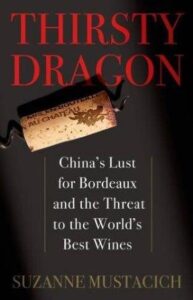
If you’ve wondered about the who, how, when and why Bordeaux became the hottest wine in the Chinese market with such incredible fury, read the new book by Suzanne Mustacich, “Thirsty Dragon: China’s Lust for Bordeaux and the Threat to the World’s Best Wines.”
The book is not for everyone, in part, because Bordeaux in China is about such a specific topic. The book easily flows between fascinating to mundane and geeky and back again as quickly as great wines flow from the bottle. That being said, if the topic interests you, there is no better source material for you to read.
For many people, the birth of the Thirsty Dragon which sparked the new, hot romance of Bordeaux in China begins in 2008, when taxes on French wine imports were reduced to zero, thanks to the efforts of the famous wine collector, Henry Tang, who was also the Hong Kong Chief Secretary. As the book explains, that is not the case.
The initial seeds for the marriage between Bordeaux and China were planted 2 decades earlier, in 1988, when Montrose Food and Beverages opened its doors and became the exclusive distributor for many of the most in-demand Bordeaux wines, including Chateau Lafite Rothschild. The tome delves into fascinating details about the early pioneers in the Chinese market. Don St. Pierre Sr. and his son figure prominently in the book, as they should. Already active in China by 1985, although not in the wine business, Don St. Pierre Sr. went on to found ASC, the Asia Solutions Company, which became one of the true powerhouses in the Chinese wine market.
Suzanne Mustacich goes further than listing the known players, she also lays out the political and financial necessity of doing business with the Chinese Government, for those that want to do serious business in China.
Jean-Guillaume Prats, whose family owned Cos d’Estournel in St. Estephe was also an early participant in China. Prats went to the region in 1995 hoping to find or create a new market for their wines. It was slow going at first, mostly because the market was small, with scant product to sell. In a few years, the Chinese market took off! By 1997, Berry Brothers and Bordeaux Index were already fighting for market share.
Things finally exploded into a boom market Bordeaux had never seen before. The book takes you through the catalyst for the explosion and the reason behind the implosion in detail.
What really makes the book memorable is the use of real names and quotes from people in the industry about Bordeaux and the Chinese market. Some of those named, were not too happy being part of the book. But that is what a good journalist does. She also got numerous reliable sources to go on the record and spill, little known secrets that only people deep inside the trade were aware of.
The explosion of the Bordeaux market, which quadrupled prices overnight, kicked off in 2008. The lowering of import taxes on wine to zero was the impetus for the initial jump, but the desire for good old fashioned, capitalistic profit, coupled with the value of gifting expensive wines to the right people for favors catapulted the Chinese market for Bordeaux into the stratosphere! The first wine auction held by Acker Merral and Condit in Hong Kong realized prices that were so high, they could never have even been dreamt of.
From that point forward, new companies could not open fast enough, and buyers could not pull out their wallets quick enough to satisfy their burgeoning market or the profit hungry negociants and chateau owners. That was just the beginning of the explosion, which the book covers in detail.
This is where you picture Henry Hill in “Goodfellas saying, “Those were the good times, then came the bad times,” which you heard just before the implosion of the Chinese Bordeaux market.
Chateau Lafite Rothschild led the train up with its incredible rise in prices. The other First Growths were not far behind. When the 2009 Bordeaux vintage was offered, the market was off the charts, in volume and price. By the time the 2010 wines were ready for delivery, Newton’s law came into play and Lafite Rothschild led the market back down again, and the ride down was much faster and dropped much farther than the road up. Hundreds of millions were lost by speculators.
The book goes into detail on the tens of millions worth of Bordeaux that Chinese merchants returned, (Their view) or the tens of millions worth of wine Chinese merchants walked out on, refusing to pay for their commitments, which is how the negociants saw it. The book spills what many see as embarrassingly, specific details on the wines returned, who walked out on the deals, and who was left holding the bag.
The completely diametrically opposite way of viewing the situation is one of the most interesting aspects of the book. To the Chinese, this was simply good business. After all, why lose money? To the Bordeaux merchants and chateau owners with hundreds of years in the trade, this was bad business, a deal was a deal, win, lose or draw. That coupled with the problems caused by the Chinese not understanding all top wines were sold on the Place de Bordeaux through the negociant system, making sales only possible if they were purchased through middlemen, created a culture clash. It also gave birth to a new market for custom bottlings and labeling of mundane Bordeaux wines to sell as exclusives to the growing Chinese marketplace.
The temporary nail in the coffin, (Temporary for optimists, permanent for pessimists) came in 2012 when the austerity policies of Xi Jinping kicked in and Chinese citizens were no longer allowed to publically flash signs of wealth. The book also touches on the massive amount of counterfeit wines bought and sold in China.
Even more interesting is how much of a role the Chinese Government played and continues playing in the marketplace. Personally, while I understand the birth of the local Chinese wine industry taking place in areas like Ningxia are important to some people, I wish the Dragons thirst could have been quenched by drinking more Bordeaux and less Chinese wine, as I found myself skipping those passages.
If all this seems interesting to you, there is no better read in the marketplace than “Thirsty Dragon: China’s Lust for Bordeaux and the Threat to the World’s Best Wines.”
We spoke with Suzanne Mustacich in detail about The “Thirsty Dragon,” to find out just how much the Chinese market was really lusting for Bordeaux wine.
Jeff Leve – First of all, congratulations on winning the extremely prestigious, Andre Simon award for drinks! How did you take the news? ?
Suzanne Mustacich “I was enormously pleased. Stunned, really, when they called my name at the awards ceremony. Thirsty Dragon is a different kind of wine book.It’s certainly encouraged me to continue writing books and tackling complex stories.”
Jeff Leve – What was your inspiration to write the book?
Suzanne Mustacich “People ask why I decided to write a book about the Chinese encounter with the French wine industry — and the answer is easy. I’ve been in Bordeaux since 1999, and I’ve covered a lot of stories, but I’ve never seen anything like this. The characters are amazing — they’re colorful, intriguing. There’s a sense of adventure and risk, of big wins, big losses, big dreams, big deceptions. And the cultural clash is fascinating.”
Jeff Leve –In many ways, isn’t that something that can be said to be taking place in other parts of the world as well?
Suzanne Mustacich “In fact, Thirsty Dragon is one part of possibly the most relevant conversation we can have today. How do we in the West do business with China without being swallowed whole? When I began investigating the story, I focused on what was unique to wine, unique to Bordeaux’s way of doing business and building markets, but gradually I realized that Bordeaux was facing what many companies and regions would eventually face when they begin trading with China.”
Jeff Leve – How long did it come to complete the book?
Suzanne Mustacich “I began gathering information in 2010, though the story hadn’t yet taken shape. I sold the book proposal in 2013, and delivered the final manuscript two years later. The research was a massive undertaking. Quite a lot of material didn’t make it into the book.”
Jeff Leve – What were some of the most surprising things you learned when writing the book?
Suzanne Mustacich “Hmmm. It takes a lot to surprise me. But I can tell you what piqued my interest. There were times when I’d be discussing a business deal that had gone sour, and the Bordelais would say, you can’t ask the Chinese person, they’ll never talk about it, the subject is ‘taboo’ or a ‘loss of face,’ yadda yadda. So I’d contact the Chinese person and ask about the taboo subject. I can tell you that the only subject off limits was their family. They were happy to discuss, for instance, cancelled orders or attempts to remove intermediaries. This was business. This was how they did business and it was a business model that had made them very rich. Why wouldn’t they talk about it?”
Jeff Leve – Was there anyone person that you wish you could have interviewed for the book, but they were unavailable for one reason or another?
Suzanne Mustacich “I can only think of three, and two were criminals! The third was involved in some shenanigans. It’s unfortunate, but shady people often avoid journalists. But I interviewed many, many people for the book, and greatly appreciated the stories they shared.”
Jeff Leve – As the book can be unflinching candid in spots, what has been the reaction in Bordeaux?
Suzanne Mustacich “So far the reaction in Bordeaux has been one of respect. I’ve been told several times that I was fair. People are generally very impressed with the amount of work I did. But mainly, they really enjoyed reading about people they know – and in some cases, themselves – in a book with suspense and adventure. They weren’t expecting that.”
Jeff Leve – What about in China? Was the reaction different?
Suzanne Mustacich “In general, people in Asia, seem to regard this as a book about China, not Bordeaux. For them, it’s an interesting addition to an ongoing conversation. The Chinese edition will be released in June and the Taiwanese edition will also be released this year. Both are mainstream, well-regarded publishers. The feedback I’ve had from Hong Kong Chinese readers has been positive so far. They seem to really enjoy a) a business book about wine, and b) a book that puts the story in the context of China’s drive to move millions out of poverty.”
Jeff Leve – What do you think are the prospects for the 2015 Bordeaux vintage selling as a future in China?
Suzanne Mustacich “I don’t think there’s much interest in buying Bordeaux en primeur in China. Collectors and traders lost money on the disastrously overpriced 2010 vintage. They haven’t forgotten. And that impacts the trade not only in Bordeaux, but in London and Hong Kong. There is still a lot of uncorked 1855 grand cru classé wine in China that needs to work its way through the system. I expect there will be some cautious purchases, perhaps for those who collect large formats. But the myth of scarcity – that you’d better buy the wine now or you’ll never get any – is shot. There’s plenty of excellent, moderately aged Bordeaux available to retailers and consumers. Plus, there is the uncertainty hovering around the Chinese economy at the moment, not to mention Europe and the UK. No one is quite sure where we’ll be in terms of exchange rates in two years. But I do think there will be interest in the vintage in China — but they’ll be looking for good deals, great quality at relatively low prices, which eliminates that group of ’en primeur’ wines at the top end. Certainly Chinese investors will be looking at prices. We’ll just have to wait and see what the chateaux do in terms of pricing their wines.”
Jeff Leve – Sales of vineyards have with only 2 exceptions, not focused on trophy properties. Not that many top estates come up for sale that often. But from what you learned, do you think there is interest in buying a trophy estate, should one come up for sale?
Suzanne Mustacich “Absolutely. I don’t think that has changed. Chinese investors continue to snap up Bordeaux estates – mainly these are not trophy estates, as you say. But that doesn’t mean they wouldn’t like to own a trophy estate. Eventually it will happen. I think it will be someone who has come to be accepted in wine circles, so it won’t be ‘shocking.’ It’ll be, oh yes, of course, we’ve known him for years. But these estates are worth huge sums today. That’s why we see so many institutional investors. Chinese investors, private or state-controlled conglomerates, can certainly go toe to toe with any Western company in a bidding war. They’ve shown that over and over again.”
Jeff Leve – What do you see as the long prospects for Bordeaux sales in China?
Suzanne Mustacich “It’s been a roller coaster ride for Bordeaux, but the long-term prospects for everyday Bordeaux is very strong. They can deliver quality, quantity and price as well as the brand ‘Bordeaux’. Remember Bordeaux produces roughly 700 million bottles a year and only 5 or 6% is Grand Cru Classe’. It’s the expensive Bordeaux that’s been hit by the anti-corruption campaign. But as China’s urban middle class expands, wine consumption increases. They’re ordering online and buying inexpensive wine. They’re trying different kinds of wines. Bordeaux has strong recognition, so if it’s priced for this market, it should sell. When China opened to the West, Bordeaux was shipping fewer than 4000 bottles to China. It was about 55 million for the 12 month period June 2014- June 2015. That is a phenomenal success that people tend to forget.”





3 Comments
Thirsty Dragon new book on Bordeaux & China Review & Interview w/ author Suzanne Mustacich https://t.co/ZYZsMl899p https://t.co/m92ihKJcwp
#WineTalk: Suzanne Mustacich Bordeaux in China Thirsty Dragon, Review, Interview https://t.co/9r5jyu2w1u
RT @JeffLeve: Everything you want to know about The quickie romance & messy breakup w/ BDX & China by Suzanne Mustacich https://t.co/ZYZsMl…